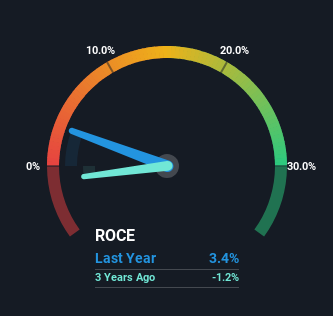- Australia
- /
- Oil and Gas
- /
- ASX:VEA
Investors Could Be Concerned With Viva Energy Group's (ASX:VEA) Returns On Capital
Did you know there are some financial metrics that can provide clues of a potential multi-bagger? One common approach is to try and find a company with returns on capital employed (ROCE) that are increasing, in conjunction with a growing amount of capital employed. This shows us that it's a compounding machine, able to continually reinvest its earnings back into the business and generate higher returns. However, after briefly looking over the numbers, we don't think Viva Energy Group (ASX:VEA) has the makings of a multi-bagger going forward, but let's have a look at why that may be.
What Is Return On Capital Employed (ROCE)?
For those who don't know, ROCE is a measure of a company's yearly pre-tax profit (its return), relative to the capital employed in the business. The formula for this calculation on Viva Energy Group is:
Return on Capital Employed = Earnings Before Interest and Tax (EBIT) ÷ (Total Assets - Current Liabilities)
0.034 = AU$168m ÷ (AU$8.6b - AU$3.7b) (Based on the trailing twelve months to June 2023).
Thus, Viva Energy Group has an ROCE of 3.4%. Ultimately, that's a low return and it under-performs the Oil and Gas industry average of 16%.
Check out our latest analysis for Viva Energy Group

Above you can see how the current ROCE for Viva Energy Group compares to its prior returns on capital, but there's only so much you can tell from the past. If you'd like, you can check out the forecasts from the analysts covering Viva Energy Group here for free.
The Trend Of ROCE
When we looked at the ROCE trend at Viva Energy Group, we didn't gain much confidence. Over the last five years, returns on capital have decreased to 3.4% from 11% five years ago. However, given capital employed and revenue have both increased it appears that the business is currently pursuing growth, at the consequence of short term returns. If these investments prove successful, this can bode very well for long term stock performance.
On a side note, Viva Energy Group's current liabilities are still rather high at 42% of total assets. This effectively means that suppliers (or short-term creditors) are funding a large portion of the business, so just be aware that this can introduce some elements of risk. Ideally we'd like to see this reduce as that would mean fewer obligations bearing risks.
What We Can Learn From Viva Energy Group's ROCE
In summary, despite lower returns in the short term, we're encouraged to see that Viva Energy Group is reinvesting for growth and has higher sales as a result. And long term investors must be optimistic going forward because the stock has returned a huge 124% to shareholders in the last five years. So should these growth trends continue, we'd be optimistic on the stock going forward.
If you'd like to know more about Viva Energy Group, we've spotted 2 warning signs, and 1 of them is potentially serious.
For those who like to invest in solid companies, check out this free list of companies with solid balance sheets and high returns on equity.
New: Manage All Your Stock Portfolios in One Place
We've created the ultimate portfolio companion for stock investors, and it's free.
• Connect an unlimited number of Portfolios and see your total in one currency
• Be alerted to new Warning Signs or Risks via email or mobile
• Track the Fair Value of your stocks
Have feedback on this article? Concerned about the content? Get in touch with us directly. Alternatively, email editorial-team (at) simplywallst.com.
This article by Simply Wall St is general in nature. We provide commentary based on historical data and analyst forecasts only using an unbiased methodology and our articles are not intended to be financial advice. It does not constitute a recommendation to buy or sell any stock, and does not take account of your objectives, or your financial situation. We aim to bring you long-term focused analysis driven by fundamental data. Note that our analysis may not factor in the latest price-sensitive company announcements or qualitative material. Simply Wall St has no position in any stocks mentioned.
About ASX:VEA
Viva Energy Group
Operates as an energy company in Australia, Singapore, and Papua New Guinea.
Undervalued with reasonable growth potential.
Similar Companies
Market Insights
Community Narratives



